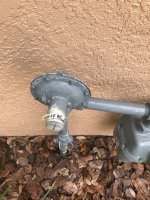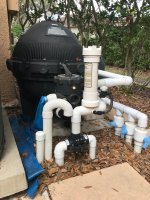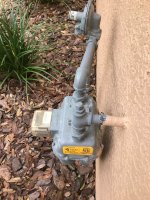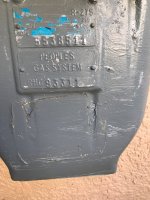I have the following: 14K gal pool, StaRite SuperMax VS var spd pump, StaRite Vertical Grid filter S8D110 DE & Pentair model 320 chlorinator. We just picked up 4-yr old StaRite Max SR400LP & just picked up the orifice to convert to NA.
I assume the newly acquired heater will connect to this system, no issues. Just add after heater & before chlorinator & add valves to bypass heater. Any suggestions here?
Saw mention of a fireman's switch. What do I need to do here, if anything?
My pump is variable speed. Is there an output contact to wire to the heater to be sure the heater doesn't run when the pump is off? Or can you set the heater to only run for a certain amount of time which would be less than when the pump runs?
I do not have a gas line run to the heater area yet. It's about a 65' run. Wondering if I can install my own line since it's a straight shot down the side of the house & is it best/easiest to use polyethylene (special tools needed) or galvanized or black iron pipe. Would you install underground or above ground? Depth or height for each option? I believe 65' requires 1-1/4" for the 400K btu. But the fittings at the gas meter look like 3/4". Is it ok to upsize after meter and then downsize again where it enters heater?
If I choose to have the work done due to all of the coordination needed between system parts, any idea of cost? Is there a single person I can call to do the entire heater install? Would you check with a local pool co like Leslie's or Pinch a penny? Other?
Thanks for your help in advance.
"New to Tampa & pool life"
I assume the newly acquired heater will connect to this system, no issues. Just add after heater & before chlorinator & add valves to bypass heater. Any suggestions here?
Saw mention of a fireman's switch. What do I need to do here, if anything?
My pump is variable speed. Is there an output contact to wire to the heater to be sure the heater doesn't run when the pump is off? Or can you set the heater to only run for a certain amount of time which would be less than when the pump runs?
I do not have a gas line run to the heater area yet. It's about a 65' run. Wondering if I can install my own line since it's a straight shot down the side of the house & is it best/easiest to use polyethylene (special tools needed) or galvanized or black iron pipe. Would you install underground or above ground? Depth or height for each option? I believe 65' requires 1-1/4" for the 400K btu. But the fittings at the gas meter look like 3/4". Is it ok to upsize after meter and then downsize again where it enters heater?
If I choose to have the work done due to all of the coordination needed between system parts, any idea of cost? Is there a single person I can call to do the entire heater install? Would you check with a local pool co like Leslie's or Pinch a penny? Other?
Thanks for your help in advance.
"New to Tampa & pool life"















